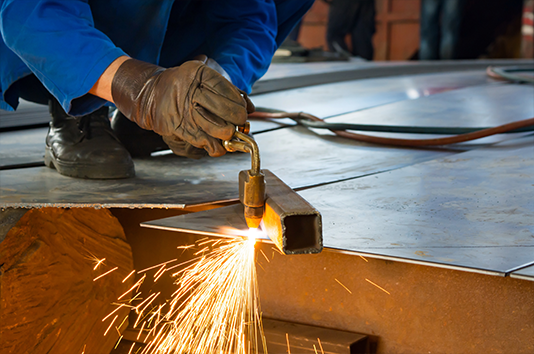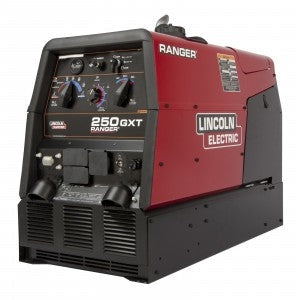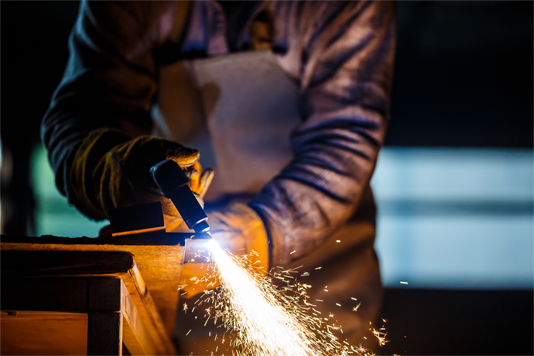Oxyacetylene cutting is a process often used in welding and fabrication, involving a unique blend of oxygen and acetylene gas to create a flame hot enough to slice through metal with ease. Understanding the principles behind this technique is crucial for anyone involved in metalworking.
Oxyacetylene cutting, when used properly, is no more dangerous than driving a car with 30 gallons of gas in the tank. But when used recklessly, it’s basically a flamethrower. So in the dear, sweet name of safety, we’re going to teach you how not to die and/or blow up while oxyacetylene cutting.
So How Does Oxyacetylene Cutting Work?
The “oxy” in oxyacetylene means oxidation. When oxidation happens slowly, it’s called rusting. But when it happens quickly, it’s called combustion or burning. The oxyacetylene cutting method oxidizes the metal super fast, which means the metal is not melting, but actually burning as you’re cutting. Acetylene gas is used because it produces the highest temperature of all flame gases (a scorching 5720°F compared to a max temperature of 5122°F with propane). The hotter the flame, the faster the piercing speed and the more time you save as a welder.
Obviously, 5720°F will tear up the human body pretty quickly, which is why cutting with an oxygen-acetylene torch requires additional safety precautions. Oxyacetylene gas cutting accidents are serious issues and can be avoided by following these oxyacetylene cutting torch safety tips:
Keep Your Cylinder Upright
An oxyacetylene cylinder is hollow and saturated with liquid acetone to keep the acetylene gases stable under pressure. Always keep your cylinder upright and secure so it doesn’t tip over. If the cylinder is tipped, the acetone can leak into the valve and make the cylinder unstable. This can be a major explosive hazard. Also, if the valve is knocked off while on its side at full pressure, the cylinder will basically become a deadly flying missile propelled by compressed gas, capable of breaking through brick walls. If your acetylene cylinder has tipped, you should place it upright for twice as long as it was lying down before you use it.
Fuel Leakage
Performing a leak test on your acetylene cutting torch on a regular basis is a really good idea. Apply a leak detection solution to the valve, hose, regulator, and torch connections and look for bubbles. If there’s a leak, it’s best to get it fixed immediately. When fixing a hose, use fittings made of bronze or brass. Don’t use copper fittings! This will create copper acetylide, which again, may explode.
Flashback and Backfire
A flashback is when the flame disappears from the end of the welding tip, causing gas to burn within the torch or beyond further into the hoses and regulators. Flashback can also occur when the gases are allowed to mix somewhere other than in the mixing chamber. Regardless of how it happens, a flashback can cause the cylinders to explode, which can lead to serious injury. A backfire is a loud cracking or popping sound caused when the gases inside of the nozzle become ignited before extinguishing — backfires can also cause explosions.
One way to prevent flashbacks or backfires is to make sure your equipment has a non-return valve, which will detect and stop reverse gas flow. Another must-have device is the flashback arrestor, designed to prevent flames from reaching the regulator. Some other ways to prevent flashback or backfire include keeping the pressure below 15 pounds, purging your hoses before lighting the torch, and installing your check valves properly.
Additional Safety Tips for Using Oxy-Fuel Torches
When it comes to oxyacetylene cutting, safety is paramount due to the high temperatures and flammable gases involved. Here are some essential safety tips to consider:
- Proper Training: Ensure that you are properly trained in using oxyacetylene equipment. Understanding the equipment and process is crucial for safe operation.
- Use Protective Gear: Always wear the appropriate personal protective equipment (PPE). This includes fire-resistant clothing, safety glasses or goggles, gloves, and ear protection. A face shield is also recommended when cutting.
- Check Equipment Regularly: Before each use, inspect the torch, hoses, regulators, and cylinders for any signs of damage or wear. Ensure all connections are tight to avoid gas leaks.
- Avoid Flammable Materials: Keep the cutting area free of flammable materials. Ensure good ventilation in the working area to disperse gas fumes.
- Light the Torch Properly: Open the acetylene valve slightly and light the torch with a striker. Then, slowly open the oxygen valve to adjust the flame. Never use a match or lighter.
- Shut Down Properly: Close the acetylene valve first, then the oxygen valve when you finish cutting. Bleed the lines to remove gas before storing the equipment.
- Emergency Preparedness: Be familiar with emergency procedures in case of a fire or accident. Have fire extinguishers and first-aid kits readily available.
- Avoid Copper Fittings for Hoses: Use bronze or brass fittings when repairing hoses. Copper can react with acetylene and create highly explosive compounds.
- Proper Disposal of Waste: Dispose of any waste materials or slag from the cutting process safely and according to local regulations.
Don’t Be Scared, Be Safe
Oxyacetylene cutting is a powerful and efficient technique in the field of metalworking, offering unparalleled precision and speed. However, the extreme temperatures involved and the potential hazards of working with acetylene gas underscore the importance of safety precautions.
Adhering to guidelines like maintaining upright cylinder storage, conducting regular leak tests, and using safety devices like flashback arrestors and non-return valves are essential to prevent accidents. By combining this meticulous approach to safety with the technical prowess of oxyacetylene cutting, welders can harness this formidable method to its fullest potential, ensuring both efficiency and safety in their work.
There’s no reason to be scared of oxyacetylene cutting. Millions of people use this method every single day without exploding. Just remember to follow these tips and use functioning, reliable equipment. If you’re looking for some oxyacetylene gear you can trust, from oxy-fuel cutting torches to MIG welders, we stock the most dependable brands in the business. Click the button below to explore all our equipment at some of the best prices available.







